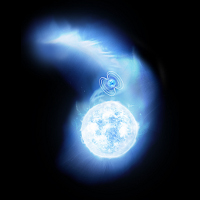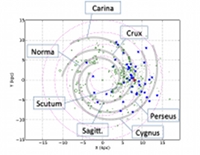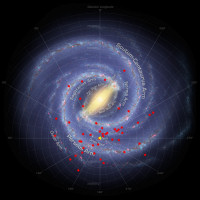High mass X-ray binaries trace the Milky Way's spiral arms
4 March 2013
Our Galaxy is littered with pairs of massive stars, many of which contain the remnants of supernova explosions. A new study of these X-ray emitting binary systems, using data from ESA's INTEGRAL space observatory, has made it possible to reconstruct the locations of the Milky Way's spiral arms many millions of years ago.High mass X-ray binaries (HMXBs) contain stars which consume their hydrogen and helium fuel so quickly that they explode as supernovas within a few tens of millions of years – the blink of an eye in the history of the Universe.
These short-lived stellar systems comprise an extremely dense, compact object (a neutron star or a black hole) which is pulling in matter ejected from a massive companion – a process known as accretion. The stellar companion is usually either a main sequence Be star or an evolved supergiant which is nearing the end of its life.
 |
|
Artist's impression of a highly obscured high-mass X-ray binary. Credit: ESA/AOES Medialab |
Be stars are rapidly rotating objects which are surrounded by a disc of gas that is ejected by the stars themselves. When the neutron star passes periodically through this disc, gas is strongly heated during accretion onto its surface, creating a blast of X-rays. In the case of supergiant X-ray binaries, the accreted material is derived from the massive companions ejecting large amounts of material in their stellar winds.
Dedicated X-ray observations of the sky, particularly with the INTEGRAL spacecraft, have quintupled the known population of high mass supergiant X-ray binaries in the Galaxy. Some 35 supergiant HMXBs are currently catalogued, out of a total of more than 200 HMXBs.
Until now, their locations within the Milky Way have not been fixed very precisely. However, most of the sources are seen to lie in the Galactic Plane and observations made with INTEGRAL over the last decade show that HMXBs seem to be associated with the spiral structure of the Galaxy.
Taking advantage of the much larger number of detected HMXBs, two French researchers decided to carry out a statistical analysis of their distribution in the Milky Way. The first step was to determine the distances of a sample of HMXBs. This was done by comparing their apparent magnitudes (brightness) with their light spectrum – a signature of their likely temperature and energy output. The spectrum of each HMXB was compared with theoretical models to compute the distance of each source.
"By using this novel technique, we were able to find a strong correlation between the positions of HMXBs and star-forming complexes in the Milky Way," said Alexis Coleiro, a PhD student at Université Paris Diderot, France, and lead author of the paper in the Astrophysical Journal.
 |
|
Distribution of high-mass X-ray binary stars and star-forming complexes. From A. Coleiro and S. Chaty, ApJ 764:185, 2013. Copyright 2013 IOP Publishing. |
Their statistical study showed that HMXBs are clustered with star formation complexes - the largest regions of star creation in galaxies. These clusters are typically 1000 light years across, with an average distance between the clusters of about 5000 light years.
"As expected, the current distribution of high mass X-ray binaries is closely linked to the stellar nurseries where they were born, some tens of millions of years ago, because the HMXBs have not been in existence long enough to have migrated very far from their birthplaces," said Coleiro.
The separation of the HMXBs and the complexes where they formed is largely due to the momentum supplied when the more massive star in the binary exploded as a supernova. Since such explosions tend to be asymmetrical, the dying star receives a kick in a particular direction. As long as the supernova's initial velocity is not too high, the binary stars are held together by their mutual gravitational attraction.
The scientists also compared the positions of current star forming regions in the Galaxy's spiral arms and a sample of 13 HMXBs. This enabled them to constrain the ages and migration distances of the HMXBs as a result of the velocity boost from the supernovas.
"We know that HMXBs are born in star forming complexes, which are usually located in the Galaxy's spiral arms," said Sylvain Chaty, a professor at Université Paris Diderot, and Alexis Coleiro's research supervisor. "Star formation in the spiral arms is triggered by density waves, regions of enhanced density where interstellar gas and dust are slowed down and compressed.
"We also know that HMXBs are short-lived, surviving for only a few tens of millions of years, so it ought to be possible to link them to their birthplaces. As a result, we decided to investigate the relationship between the binary systems and the spiral structure of the Milky Way."
 |
|
High-mass X-ray binary systems in the Milky Way. |
By assuming that the density waves rotate at a different speed to the matter (stars, dust etc.) in the Galaxy, it was possible to calculate the expected HMXB locations relative to the positions of the spiral arms at certain times in the past. The researchers then compared these positions with the current locations of 13 HMXBs in order to determine the effects of the kicks they received from the supernova explosions.
Their calculations showed that the mean age of four supernova HMXBs was 45 million years, with a mean migration distance of about 325 light years. The mean age of nine Be-class HMXBs was 51 million years, with a mean migration distance of about 360 light years.
"For the first time, we have accurately derived the distances and distribution of a large sample of high mass X-ray binaries in our Galaxy, bringing new constraints on their formation and evolution," said Coleiro.
"These new methods will allow us to assess the influence of the environment on these high energy objects with unprecedented reliability," said Chris Winkler, ESA's INTEGRAL project scientist.
"This study was made possible because INTEGRAL is the only observatory with the sensitivity to observe numerous HMXBs in the Milky Way."
Notes for editors
The results presented here are reported in the paper "Distribution of High Mass X-ray Binaries in the Milky Way", by A. Coleiro and S. Chaty, published in The Astrophysical Journal, 764, 185, 2013. DOI:10.1088/0004-637X/764/2/185
INTEGRAL is an ESA project with instruments and science data centre funded by ESA Member States (especially the Principal Investigator countries: Denmark, France, Germany, Italy, Spain, Switzerland) and Poland, and with the participation of Russia and the USA.
Contacts
Alexis Coleiro
Laboratoire AIM - CEA CNRS
Université Paris Diderot, France
Email: alexis.coleiro![]() cea.fr
cea.fr
Sylvain Chaty
Laboratoire AIM - CEA CNRS
Université Paris Diderot, France
and Institut Universitaire de France, Paris, France
Email: chaty![]() cea.fr
cea.fr
Chris Winkler
INTEGRAL Project Scientist
Research and Scientific Support Department
Directorate of Science and Robotic Exploration
ESA, The Netherlands
Email: cwinkler![]() rssd.esa.int
rssd.esa.int
Phone: +31-71-5653591

